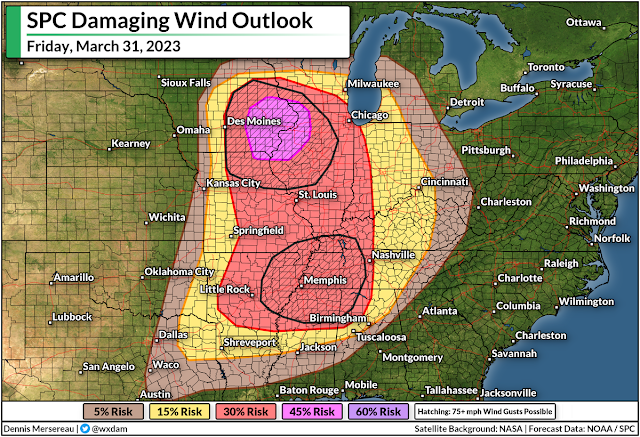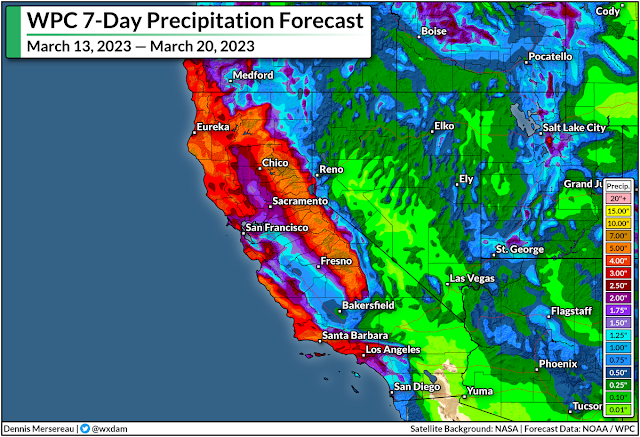Two major storms will bookend the country on Tuesday, bringing more flooding rains and prolific snows to California while New England deals with its strongest nor'easter of the season.
The Setup
A jet stream firmly parked over the southern half of the United States will set the stage for the two major systems we'll have to deal with over the next couple of days.
Out west, upper-level winds will funnel a rich plume of moisture straight into California. (Stop me if you've heard this one before.) This latest atmospheric river will fuel widespread heavy rains at lower elevations and very heavy snows for the Sierra Nevada.
Back east, the combined lift of a trough digging across Eastern Canada and that strong jet stream over the southeastern U.S. will lead to the rapid development of a low-pressure system off the Mid-Atlantic coast late Monday evening.
This low will spin itself up in a hurry, likely meeting the criteria for bombogenesis, or a "bomb cyclone" as you'll probably hear it termed. This just means that the storm's minimum pressure will deepen very quickly, leading to wicked winds and widespread heavy snowfall across much of New England.
More Flooding For California
A weather alerts map of California today looks like a toddler went at it with a fresh pack of Crayola and a vivid imagination. The state is blanketed with flood watches, wind advisories, high wind warnings, and winter storm warnings for the mountains.
Wind gusts could reach 50 mph for much of the northern half of California through Wednesday, with gusts up to 70 mph possible along the coastline and elevations above 1,000 feet. Those winds could easily lead to downed trees and power outages, especially with soils soaked from all the rain over the past couple of weeks.
There's plenty more rain where that came from. The latest forecast from the
Weather Prediction Center paints widespread rainfall totals of 3-5 inches along the coast, with up to 2.5 inches in the Central Valley and higher totals up north. Much of that precipitation in the mountains will fall as snow, with five feet of additional snow possible above 8,000 feet.
This latest slug of rain and snow will add further stress to the region's waterways, many of which already spilled over their banks with the round of precipitation a few days ago.
As always, stay alert for flooding and be prepared to change your travel route if you come across a flooded road. It's impossible to tell how deep the water is until it's too late, and it only takes a few inches of moving water to lift a vehicle and carry it downstream. California's hilly terrain increases the odds that there may not even be a roadway left under the floodwaters.
Heavy Snow And High Winds For New England
Meanwhile, the East Coast will soon deal with a storm that could be its most significant thump (in fact, one of its only bouts) of wintry weather this year.
A classic nor'easter will spin up off the East Coast tonight and roar through early Wednesday morning, targeting much of New England with heavy snow and high winds for the day Tuesday.
The storm will really get cranking early on Tuesday morning, plastering almost everyone from northeastern Pennsylvania to coastal Maine with double-digit snowfall totals by the time the storm is over on Wednesday.
Most of the snow will fall north and west of I-95, sparing Philly and New York from much more than a dusting at best. Higher elevations in upstate New York could see up to two feet of snow.
Boston is going to be right on the borderline between a nuisance and a solid storm, with about 6-8 inches of snow in the forecast right now—with much lower totals just east and much higher totals just west. It wouldn't take much of a nudge in the storm's ultimate track to push that fine line in either direction. I don't admire local meteorologists up there right now.
Strong winds of 50-60 mph are likely during the storm, which will lead to tree damage and power outages for many location. This is going to be a wet, sloppy snow, to boot, which will weigh down trees and power lines and make damage and outages even more likely. Coastal flooding is also possible.
Heavy snowfall rates and high winds will lead to reduced visibility during the height of the storm, with whiteout conditions possible at times. If you have to travel through the area, it'd be a good idea to get where you need to go by Monday night and plan to stay put for a couple of days.
















